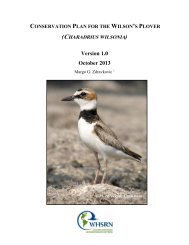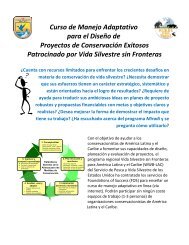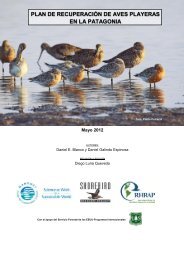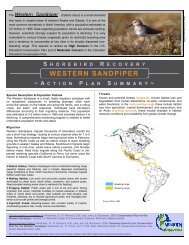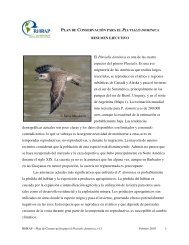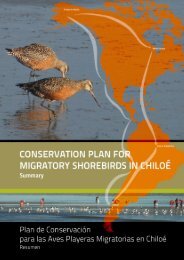Sanderling Plan - Western Hemisphere Shorebird Reserve Network
Sanderling Plan - Western Hemisphere Shorebird Reserve Network
Sanderling Plan - Western Hemisphere Shorebird Reserve Network
You also want an ePaper? Increase the reach of your titles
YUMPU automatically turns print PDFs into web optimized ePapers that Google loves.
British Columbia, Canada: <strong>Sanderling</strong>s occur in moderate numbers in British Columbia, and<br />
several sites report hundreds to low thousands of <strong>Sanderling</strong>s during migration: McIntyre Beach<br />
and Rose Spit (Queen Charlotte Islands) report 1,300 (in 1985) to 2,000 (in 1977) during<br />
migration (Campbell et al. 1990). Long Beach, BC has reported hundreds of <strong>Sanderling</strong>s during<br />
fall migration, with high counts of 500 (September 1982) and 600 (September 1985) (Paulson<br />
1993).<br />
Washington, USA - beaches on southern coast: These beaches support thousands of<br />
<strong>Sanderling</strong>s during spring and fall migration (Buchanan 1988, Evenson and Buchanan 1997).<br />
Spring migration: Southern Washington beaches represent an important staging area during<br />
spring; combined with Oregon beaches, more than 28,800 <strong>Sanderling</strong>s were recorded in this<br />
region during spring 1983 (Myers et al. 1984b), with densities reported as 185 <strong>Sanderling</strong>/km.<br />
Leadbetter Point, spring peak numbers exceed 1,000 (ISS data). Olympic-North Beach: a high<br />
count of >7,100 <strong>Sanderling</strong>s in late April/early May 1983 (Myers et al. 1984b). Grayland Beach:<br />
approximately 2,400 during late April/early May 1983 (Myers et al. 1984b). Longbeach: > 3,800<br />
<strong>Sanderling</strong>s were counted here in spring 1983 (Myers et al. 1984b). Fall migration: Longbeach<br />
Peninsula is an important staging area and has supported thousands of <strong>Sanderling</strong>s each fall, such<br />
as 213.5 <strong>Sanderling</strong>s/km (7,900 total birds) on 30 August, 1993 (Buchanan and Evenson 1997,<br />
J. Buchanan, unpubl. data). Leadbetter Point fall peak numbers exceeded 5,000 during fall<br />
(1970s, ISS data), and 4,000 for two weeks in September and October 1978 (see Paulson 1993);<br />
Copalis/Ocean Shores fall counts included 1,000 birds in 1979 (Paulson 1993) and >1,000 in the<br />
1990s (ISS data) (Myers et al. 1984b).<br />
Oregon - north coast sandy beaches: Oregon’s sandy beaches represent a major staging area on<br />
the North American Pacific Coast (Myers et al. 1984a, 1984b); combined with Washington<br />
beaches, more than 28,800 <strong>Sanderling</strong>s were recorded in this region during spring 1983 (Myers<br />
et al. 1984b). Spring migration: High counts include the following: South jetty of Columbia<br />
River: 30,000 in 4.8 kilometers of beach in May 1978 (Paulson 1993); Clatsop Beach:<br />
approximately 12,000 <strong>Sanderling</strong>s (472/km) were reported here in late April/early May in 1983<br />
(Myers et al. 1984b); Sunset Beach: 20,000 in May 1977 (Paulson 1993); Oregon Dunes<br />
National Recreation Area supported at least 5,000 <strong>Sanderling</strong>s in exceptionally high densities<br />
(117 to 158 birds/km) during late April/early May 1983 (Myers et al. 1984b). Fall migration:<br />
WHSRN – <strong>Sanderling</strong> Conservation <strong>Plan</strong>, February 2010, v1.1 29





